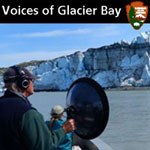Notes on Sound Clips
The recordings below were made by the National Park Service, using a hydrophone that is anchored near the mouth of Glacier Bay, Alaska for the purpose of monitoring ambient noise. The recordings are intended to provide examples of the types of natural and manmade sounds that occur in Glacier Bay National Park.
Whale Sounds
Humpback Whale
(Megaptera novaeangliae)
Humpback whale song is thought to be a male breeding display that is prominent in their wintering grounds, and previously thought to be quite rare in the feeding areas. It is called a song because it is a long, complex vocalization that repeats in a predictable pattern. Whale song recordings from Glacier Bay have been made only in the fall, when perhaps the hormonal changes that spur whales to migrate are beginning to occur.
Feeding call is a sterotyped vocalization typically used during humpback whale coordinated group feeding. In the Glacier Bay area, it typically occurs 15-20 seconds before a group of whales all surface together after a foraging dive. This specialized call is common in some localities but rare in others. It may be used for group coordination, (ready, set, go!) or to scare/concentrate the schooling fish that are their prey.
Unstructured sounds. The most common humpback whale vocalization in Bartlett Cove was the simple “whup”, made with no discernable pattern. The track entitled “moo etc”is a sample of common humpback whale vocalizations on a somewhat windy day. Whales can also make non-vocal sounds by slapping their tail, flippers or other body parts on the water (for example during a breach). These sounds can carry for hundreds of meters and seem to provide another way for whales to communicate with one another over distance. As you will hear twice near the end of the cut titled “wheezeblow etc”, even the whale’s breathing can be audible at some distance, especially wheeze blows.
The humpback whale song recorded with the boat in the foreground illustrates that whale sounds and manmade sounds co-exist in the marine environment, with unknown effects on whales and other marine life. In one of the recordings, the sound of repeated tail slaps overlaps with the loud, high-pitched whining of a propeller in bad repair, perhaps indicating that the sound disturbed the whale.
Use the audio players below this section to listen online, or download mp3 files directly with these links (right click- 'save link as'):
2020 possible humpback whale mom / calf vocals with harbor seal
2020 humpbacks and harbor seals in quiet
2020 humpback whale slaps and vocals with harbor seal
Contact Call (moo)
Contact Call (whup)
Flipper Slap
Vocals and wheeze-blow
Tail Slaps with Propeller Whine
Whale Song with Outboard Engine Noise

